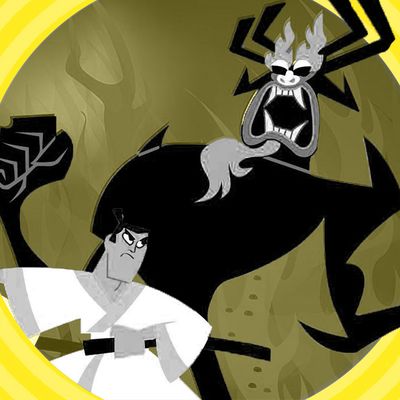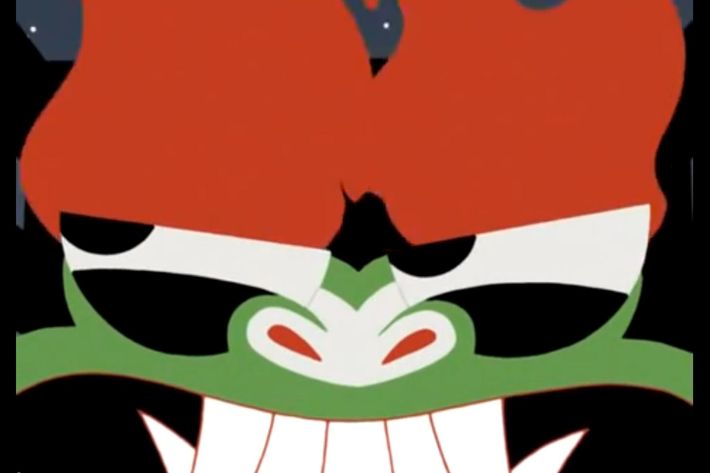
Genndy Tartakovsky’s Cartoon Network series Samurai Jack and Star Wars: Clone Wars didn’t air all that long ago, yet they already seem to have been forgotten. This is a travesty I try to correct whenever cartoons are being discussed, and sometimes when they aren’t. These masterworks should be perched near the top of any list of the greatest animated programs ever shown on American TV. They should also land on any informed list of the greatest action filmmaking of all time, and the Russian-born Tartakovsky, who also created the great Dexter’s Laboratory and Powerpuff Girls, should claim an automatic spot on any list of the greatest action filmmakers. With his unerring grasp of composition, editing, and screen direction, his ability to move his virtual “camera” to conceal or reveal information, and his ability to build excitement through design, sound effects, music, and silence, he’s as much of a master as Steven Spielberg, James Cameron, John Woo, Kathryn Bigelow, or Buster Keaton.
I should stress up top that although Tartakovsky is a good storyteller, in a silent-movie sort of way — expressing what’s happening moment-to-moment through picture and sound rather than in dialogue — I never watched either of these programs for their plots, and I don’t re-watch them for narrative, either. I re-watch them for the same reason that I visit art museums, attend live concerts, and pause during journeys from point A to point B in New York to watch dancers, acrobats, or street musicians: because I appreciate virtuosity for its own sake. And that’s what Tartakovsky’s Clone Wars and Samurai Jack give you, scene for scene and shot for shot. Samurai Jack, about a samurai battling creatures, robots, and an ancient demon in a post-apocalyptic future, owes a rather large debt to Frank Miller’s purely action-driven comics, particularly Ronin and 300, as well as to the paintings of Katsushika Hokusai and the schlocky 1980s Saturday-morning adventure Thundarr the Barbarian. The Clone Wars envisions the events that transpired between the first and third Star Wars prequels, but concentrates almost entirely on military history: wins, losses, and quagmires for the Republic that would later sour and become an Empire.
Both shows were broken up into collections of short subjects that would show, say, Jack facing down a particular enemy in a foggy canyon or a menacing forest, or a particular Jedi taking part in specific military campaigns (space battles, land wars, urban guerrilla actions, rescues, and the like) during an intergalactic civil war. But the plot was never the point. It was always about the visual music that Tartakovsky, his designers, and his animators created onscreen.
Just look at this scene of Jack facing down the demon Aku.
There’s so much to admire here, so many touches that bespeak tremendous confidence and control, from the way that Aku’s sticklike “combat” form seems to have been burned or sprayed onto the frame to the way the tombstones recede into the smoggy middle ground and background, to the percussive score (a common feature in Tartakovsky action) that gives the confrontation a ritualized, at times preordained feeling. At the :32 mark you’ll seen an example of what I mean when I say that the filmmaker knows how to use shot composition and screen direction to create surprise: Jack runs across the screen and passes a stone monument, which seems to slice itself in half vertically, revealing the demon (whom you expected to pursue Jack from screen left) behind it. The minimalist designs are exciting in and of themselves. I love the close-up of Aku right after he cuts that monument in half:

Solid black, white, green, and red: Those are the only colors. Less is always more in Tartakovsky. He’s the action filmmaker as sketch artist, only drawing what needs be drawn to capture the essence of a moment, the heart of an action.
The Clone Wars combined Samurai Jack’s punchy minimalist filmmaking with a dazzling sense of scale. The Jedi characters (whose ranks include such “names” as Obi-Wan, Anakin, and Mace Windu, as well as many more who were supporting or nameless in the prequels) are often juxtaposed against teeming hordes of clone warriors, robots, creatures, armored personnel carriers, hovercraft, and sometimes immense mechanical things whose precise purpose remains unknown until it’s finally revealed to us. Tartakovsky has that Steven Spielberg talent for building anticipation through silence and sound effects. Often a new and fearsome enemy’s arrival will be heralded by the disappearance of soundtrack music, then an eerie silence, then an ominous rumble, then some kind of visual flourish, such as a cut to an overhead shot that shows a shadow passing over our heroes, who from that vantage point seem pitifully tiny and hopelessly overmatched.
There’s a wonderful small moment at the :25 mark in this clip of General Grievous and his droid army battling the Jedi that illustrates what I’m talking about. The General leads his robot army toward a field of wrecked spaceships where beleaguered Jedi are hiding. The General stops marching and holds up his mailed fist. The robots halt. Silence. The scene zooms back to reveal the wrecked spacecraft, the robots arranged in an elegant diagonal pattern. Then there’s a cut to a series of shots of a lone Jedi, Ki-Adi-Mundi, sneaking about. Every shot looks like a woodcut (I love the use of foreground wreckage to create frames-within-frames). The only noise is a faint breeze and the sound of his footsteps as he runs.
I regularly re-watch my old DVDs of Samurai Jack and The Clone Wars (the two-dimensional version, not the follow-up that debuted in 2008, which is quite good but not on the level of Tartakovsky). They have never failed to mesmerize and sometimes astonish me. I’ve seen every episode at least three times over the years, and I keep noticing new things: bits of visual foreshadowing, background or foreground details I’d failed to appreciate previously, such as the irislike forest of thorns that Jack enters at the start of the “Spring” section of “The Four Seasons of Death,” or the John Ford–like majesty at the very end of this Mace Windu adventure, with the Jedi and a small boy standing on a hilltop after a battle. These two shows are treasure troves of graphic design and pure showmanship. People remember Dexter’s Laboratory and Powerpuff Girls, as well they should: They’re classics. But Tartakovsky’s more abstract and daring Samurai Jack and Clone Wars should get some love, too, along with dedicated slots on Cartoon Network or its sister network, Boomerang (which reran Jack last year), and handsomely designed Blu-ray box sets with loads of extras.


